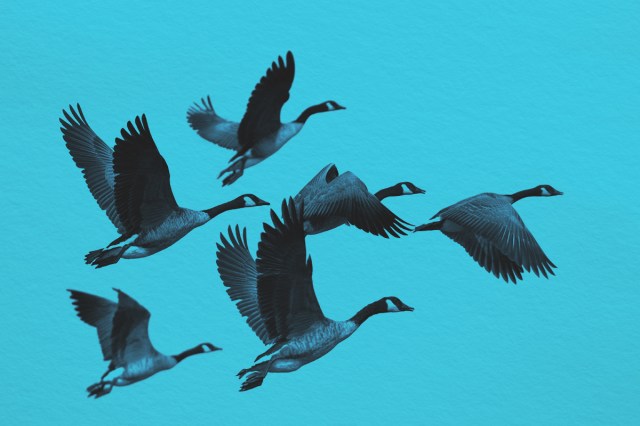
If you’ve ever researched the strange terminology for animal groups (known as terms of venery), you know there’s a lot more than just herds and packs. Where did these oddball collective nouns come from? We’ve uncovered the origin stories for some of the most interesting animal group names out there. Keep reading — one of them might become your next fun fact at a cocktail party.
“Venery” is an old-school term for hunting. It wasn’t scientists who coined fanciful names such as “a charm of hummingbirds” or “a cauldron of bats.” Rather, 15th-century Englishmen (who were typically wealthy and educated) would come up with names for animal groups while hunting. These collective nouns, known as “terms of venery,” eventually found their way into books. And although they were never fully adopted by the scientific community, they’ve managed to stick around as a clever way to show off your animal knowledge (and vocabulary).
There are multiple literary references to a wise group of owls. C.S. Lewis’ classic tales The Chronicles of Narnia feature a parliament of owls that meet at night to review the affairs of Narnia. The term is a reference to a Geoffrey Chaucer poem titled “Parliament of Foules” (fowls), which was written in the 14th century.
We’re not sure why a “piteousness of doves” deserves our pity, but we’ll give it to these heavenly creatures. Dark-winged crows, however, have a more sinister reputation. Coincidence or not, they often appear in cemeteries, on battlefields, or just about anywhere disaster has struck. That, plus the loud, harsh cries they make when in a pack, contributed to this macabre name.
Given the close connection between humans and primates, this seems to be an adept way to describe a cluster of intelligent monkeys. However, when the term was coined in the 15th century, “shrewdness” meant “wickedness,” which was likely related to the natural mischievousness of monkeys. As language evolved, this name came to suit clever apes even more astutely.
In all the terms of venery crafted over the centuries, poor hippos were left out until the early 20th century, when they were given this rather unfortunate collective noun in a hunting and fishing manual. That’s not to say the name isn’t appropriate. Male hippos can weigh more than 7,000 pounds and have a thick layer of subcutaneous fat that helps them float and, yes, makes them look bloated.
Compared to most terms of venery, this example is a bit more well known, thanks to its charming alliteration. Geese were given this label to describe their general noisiness — if you’ve ever been around the loud, squawking, honking sounds they make when clustered in a group, you understand why.
With their bright pink feathers and sassy one-legged stance, no animals better represent the word “flamboyant” than flamingos. In fact, their name and collective noun can be traced back to similar sources. “Flamingo” comes from the Latin flamma, meaning “a flame,” while the word “flamboyance” is derived from French, but traces back to the same Latin root. It’s not clear when the phrase “flamboyance of flamingos” was first coined, but some early evidence can be traced back to the 1930s, when captive breeding colonies of flamingos were first cultivated in South Florida.
While it’s fun to imagine ferrets wearing suits and ties around a big boardroom table, the phrase “business of ferrets” is the result of an archaic term from the Middle Ages. The 1486 Book of St. Albans made reference to a “besynes” of ferrets, which described the busy and energetic nature of these furry creatures. As the English lexicon evolved, the collective noun was changed to “busy-ness” and most recently “business.” Should you want to put your pet ferret in a tie, we ask that you post pictures.
If you see a group of lemurs, they may be communicating about you behind your back. Lemurs frequently travel in large groups and secretly conspire with one another to keep each other safe. This takes the form of a behavior called mobbing, in which the lemurs collectively attack or harass a predator before it can strike. Whether you spot a conspiracy at the zoo or in the wild, the lemurs may very well be conspiring about the best way to annoy you before you can annoy them.
Cat owners know their fur babies love to cause all manner of mischief, including knocking glasses off the counter, clawing up the sofa, and midnight hallway runs. But the term “destruction” has nothing to do with house cats, which are commonly called a “clowder,” a “pounce,” or a “clutter” in groups. Rather, “a destruction of cats” refers to any roaming group of wild cats that will take necessary action to defend their territory and protect each other.
Manatees are perfectly content living a solitary lifestyle and floating through the water alone, as long as that water is warm. But as temperatures drop, manatees literally aggregate in warmer pockets found throughout the water — hence this term that’s used to describe them as a group. The phrase is a little dry for the gentle creatures also known as “sea cows,” though, so we’d suggest borrowing “bloat” from hippos and turning it into a “float of manatees.” This suggested term is apt, as the marine mammals spend 12 hours a day floating near the surface of the water, or drifting along the bottom.
The phrase “crash of rhinoceroses” has to do with the destructive yet clumsy nature of these powerful animals. Rhinos are capable of running at 30 miles per hour while also being able to see only 30 feet ahead of them. This creates the potential for unmitigated chaos, as rhinos are far too likely to crash into something at full speed. Often they’ll simply barrel through the African plains unimpeded, but there’s still a chance of them colliding with whatever awaits them ahead.
More Collective Nouns for Animals
- Coalition of cheetahs
- Convocation of eagles
- Exaltation of larks
- Galaxy of starfish
- Intrusion of cockroaches
- Lounge of lizards
- Pandemonium of parrots
- Tower of giraffes
- Unkindness of ravens
- Wisdom of wombats















